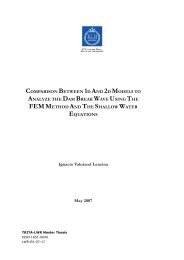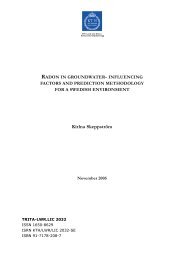water sources, infrastructure, space and the dynamics of ...
water sources, infrastructure, space and the dynamics of ...
water sources, infrastructure, space and the dynamics of ...
You also want an ePaper? Increase the reach of your titles
YUMPU automatically turns print PDFs into web optimized ePapers that Google loves.
Mat<strong>the</strong>w Biniyam KursahTRITA LWR Master ThesisSpace <strong>and</strong> incidence <strong>of</strong> malariaThis section presents <strong>and</strong> analyses results <strong>of</strong> <strong>the</strong> correlation betweendistances to <strong>the</strong> main town, <strong>water</strong>courses, roads, <strong>the</strong> type <strong>of</strong> l<strong>and</strong> cover<strong>and</strong> elevation on one h<strong>and</strong> <strong>and</strong> environmental diseases on <strong>the</strong> o<strong>the</strong>r.Table 13 shows correlation between malaria <strong>and</strong> distance to <strong>the</strong> maintown (district capital). The rationale behind this was to find out whe<strong>the</strong>rdistances to major town which is <strong>the</strong> hub <strong>of</strong> health, educational, social,economic <strong>and</strong> political activities in <strong>the</strong> district have any relationship with<strong>the</strong> occurrence <strong>of</strong> Malaria incidences. The premises are that; 1) <strong>the</strong> majortown serve as <strong>the</strong> district capital with relatively better <strong>water</strong> managementsystems, 2) majority <strong>of</strong> <strong>the</strong> most educated (defence mechanism) peopleare found in <strong>the</strong> major town, <strong>and</strong> 3) poverty is dominant in <strong>the</strong> ruralareas than <strong>the</strong> major town (hub <strong>of</strong> economic activities). However, Table13 shows that Malaria <strong>and</strong> distance to major towns (including majortowns in neighbouring districts) have an inverse correlation withsignificance <strong>of</strong> 0.001 levels. This can be explained by six main reasons; 1)<strong>the</strong> relatively dense population in Saboba township <strong>and</strong> high number <strong>of</strong>personal-house ownerships (Table 15) created so many dugout pits formosquitoes to breed, 2) <strong>the</strong> dilapidated <strong>and</strong> open gutters found in <strong>the</strong>major town serve as good grounds for mosquito larvae to grow, 3) <strong>the</strong>reare more open containers such as used cans, broken bottles etc inSaboba township than in <strong>the</strong> peripheries due to higher population, 4)relatively low hospital attendance <strong>of</strong> <strong>the</strong> peripheral areas due totransportation difficulties, illiteracy etc, 5) <strong>the</strong> open type public toilets (Fig.15) are only available in <strong>the</strong> major town; <strong>the</strong>se toilets serve as reservoirfor breeding mosquitoes, <strong>and</strong> 6) <strong>the</strong> township has a poorer sanitationthan <strong>the</strong> periphery.Table 14 shows that <strong>the</strong> relationship between Malaria <strong>and</strong> distance toroads also has an inverse relationship with a significance level <strong>of</strong> 0.026.This means that more Malaria cases are reported close to road networks.However, <strong>the</strong> closeness to roads in itself does not directly determine <strong>the</strong>presence <strong>of</strong> stagnant <strong>water</strong> to facilitate breeding <strong>of</strong> mosquito (anopheles)larvae but ra<strong>the</strong>r 1) <strong>the</strong> concentration <strong>of</strong> large population along roadnetworks means more dugout pits as a results <strong>of</strong> <strong>the</strong> need for buildings(Fig. 1), 2) <strong>the</strong> gutters constructed along road networks <strong>and</strong> <strong>the</strong> potholesfound on <strong>the</strong>se third class roads in <strong>the</strong> district may have served asbreeding grounds for mosquito larvae, <strong>and</strong> 3) low hospital attendance <strong>of</strong>those in <strong>the</strong> periphery due to transportational difficulties; account forthis relationship. This shows that Malaria is largely an urban health problemin <strong>the</strong> district.With a significant level <strong>of</strong> 0.108 <strong>and</strong> correlation <strong>of</strong> -0.190, Table 15shows that <strong>the</strong>re is no significant correlation between incidence <strong>of</strong>Malaria <strong>and</strong> distances to conventional <strong>water</strong> <strong>sources</strong> (river <strong>and</strong> streams).Three main reasons explain this surprising result. Firstly, <strong>the</strong> more visible<strong>water</strong> bodies are rivers <strong>and</strong> streams with flowing current – such flows donot facilitate high breeding <strong>of</strong> mosquitoes. Secondly, <strong>the</strong> usuallytemporary, small, stagnant <strong>and</strong> open grey <strong>water</strong> bodies which facilitate<strong>the</strong> growth <strong>of</strong> mosquitoes are not shown in <strong>the</strong> GIS analysis. Thepresence <strong>of</strong> <strong>water</strong> does not necessarily make it breeding grounds formosquitoes, but ra<strong>the</strong>r <strong>the</strong> prevailing condition <strong>of</strong> <strong>the</strong> <strong>water</strong>. The thirdreason that explains this o<strong>the</strong>rwise surprising result is <strong>the</strong> length <strong>of</strong>exposure <strong>of</strong> intermittent rivers <strong>and</strong> streams to <strong>the</strong> breeding <strong>of</strong>mosquitoes. Though, <strong>the</strong>se <strong>water</strong>courses do dry-out <strong>and</strong> “cut” at some<strong>of</strong> its sections, which could facilitate <strong>the</strong> breeding <strong>of</strong> mosquitoes, it ishindered by <strong>the</strong> differences in <strong>the</strong> timing <strong>of</strong> <strong>the</strong> dry-out period (around42
















